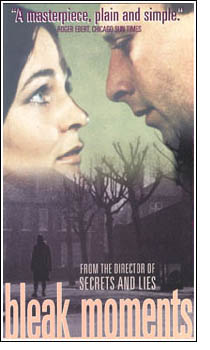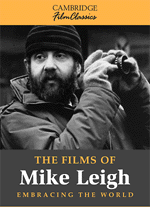|
 One
of the subtlest aspects of Leigh's work is how it delays judgment. Understanding
is incremental. Mainstream movies employ quicker ways of knowing. They
generally provide a hook on which to hang the interpretation of a character
or scene as early as possible. If it is done stylistically–by means of
a lighting effect, a mood-music orchestration, a tendentious framing,
a "black hat" bit of action–the meaning can be indicated almost
instantaneously. See this? Hear that? Get it? Got it. One
of the subtlest aspects of Leigh's work is how it delays judgment. Understanding
is incremental. Mainstream movies employ quicker ways of knowing. They
generally provide a hook on which to hang the interpretation of a character
or scene as early as possible. If it is done stylistically–by means of
a lighting effect, a mood-music orchestration, a tendentious framing,
a "black hat" bit of action–the meaning can be indicated almost
instantaneously. See this? Hear that? Get it? Got it.
Leigh replaces what might
be called knowledge as insight with knowledge as acquaintance. Rather
than seeing (or being told) something about an experience up front,
the viewer is required to live through a complex, unglossed
experience, piecing an interpretation together step by step. One
might say that while Hollywood attempts to create a feeling of God-like
omniscience in the viewer, Leigh makes us realize the all-too-human
partiality and incompleteness of each of our continuously revised
understandings. We understand Leigh's characters and situations
not with the instantaneous insight that movies usually provide,
but the way we understand things in life outside of the movies–gradually,
hesitantly, provisionally. Understanding out of time is replaced
by understanding in time; shorthand knowing gives way to longhand.
The gradualness and tentativeness of the knowing process affect
its final status. Leigh's truths stay localized, his forms of knowing
gradual and evolutionary, no matter how many times we see the movies.
The experiences in Leigh's work must be undergone for a long time
before they can be understood (if they can be understood at all).
Leigh provides shifting,
partial views of characters and situations that allow for different
(and even conflicting) understandings. This is what is potentially
misleading about most critical descriptions of Pat, Peter, the boss,
and the waiter. They look back on them and their scenes from a certain
imaginative distance, but these characters are actually encountered
by a viewer of the film far less clearly and summarily. I vividly
remember my own experience viewing Bleak Moments for the
first time with a friend. I was mystified to the point of bewilderment.
After the first scene with the boss, I whispered in her ear, "What's
his problem?" Following a scene with Peter: "Is this guy
as weird as I think he is?" After a scene with Norman: "What
a bizarre movie. What's going on?" The questions weren't rhetorical.
I didn't know what to think about what I was seeing. I was lost.
Even after the movie was over, I still couldn't have described what
I had seen or say what the film was "about." I remember
my best guess was "something to do with failures of communication
and linguistic problems," since there was so much stammering,
inarticulateness, and misunderstanding–and so much blathering on
about language by Peter. When it came to how I felt about the characters,
I couldn't make up my mind about any of them. Was I supposed to
like any of them? Was I supposed to hate any of them? Was I supposed
to blame Peter for the disastrousness of the date? Or was I supposed
to blame Sylvia? How was I supposed to feel about Norman–was he
hopeless or promising as boyfriend material? Was Sylvia actually
propositioning him in one of the final scenes, or was I just imagining
that? If so, did he realize it and deliberately reject her overture,
or was he oblivious to the whole thing? The characters and situations
resisted all of the standard psychological and moral can openers
in my interpretive Swiss Army knife. They defeated being narratively
sorted into any of the customary categories–good or bad, right
or wrong, victim or villain.
You are not really responding
to Bleak Moments if you haven't changed your mind about Hilda,
Peter, Pat, and everything else at least a few times in the course
of watching it. Leigh's narratives are structured to stay just a
little ahead of us, to prevent us from figuring out characters and
interactions prematurely, to force us to stay open. As he put it
to an interviewer: "Whatever film you watch, assuming you've
seen a film before, you immediately go into one program or another,
or plug into an expectation system. If the film is any good, these
expectations are constantly confounded."
Throughout his career,
Leigh has spoken to interviewers about his process of shifting
the
view and adjusting the viewer's relationship with his characters
and situations. As early as 1975, he was arguing: "When people
tell me that I'm just producing slices of life, they don't realize
that it's all based on a very particular kind of story-telling.
What I do is to invite the audience to go through a process of
identifying,
reacting to, reacting against, sympathizing with, caring for, getting
cheezed off with, a complex set of interactions between people...."
–Excerpted from Ray
Carney, The Films of Mike Leigh: Embracing the World (London
and New York: Cambridge University Press, 2000).
 |
  |
|
Ray
Carney's The Films of Mike Leigh is quite simply the
best book of film criticism I have ever read.
Now I have to say
that I have never read any of Carney's other books (he has
also written books on Cassavetes, Frank Capra, and Carl Dreyer),
which, for all I know, might be even better. But as a friend
of mine put it, 'His writing blows everything else out there
away, even to the point of many times seeming like simply
in a class of his own...different in kind more than degree.'
And although I admit to not having read 'everything else out
there,' I feel the exact same way. Ray Carney's new book has
undeniably rocked my world.
Ray Carney's book
is to what usually passes for film criticism what Mike Leigh's
movies are to what, in Hollywood, usually passes for filmmaking:
a truly radical critique, a whole different animal, and a
solitary voice of sanity that has somehow miraculously managed
to make itself heard over the noise and hullabaloo of this
culture's present-day insanity. |
|
–Caveh
Zahedi, creator of A Little Stiff and I Don't Hate
Las
Vegas Anymore,
in a review in Filmmaker Magazine |
| |
  |
| |
Mike Leigh’s work is difficult to pin down. Echoing what Ray Carney says of Leigh’s more blinkered characters, examining these films becomes a lot murkier when you bring too many ideas and film-critical categories to bear. Although not without its strengths and serendipities, Garry Watson’s book suffers from intellectual larding while, like one of Leigh’s more far-sighted characters, Carney and Quart’s gets in amongst the rough-and-tumble....
The Carney and Quart book was the first critical study of Leigh’s work and every subsequent book on Leigh must negotiate its rigor and insight. I have yet to read a book that better approximates my experience of watching Leigh’s films.My one regret is that, apart from the important BBC plays Nuts in May and Abigail’s Party (1977), I have yet to see many of the early works wherein Carney locates the wellspring of Leigh’s improvisatory power and vision.
Animating this study is a distinction between two types
of Leigh characters that resonates culturally, politically and
spiritually across his work. For Carney, there are those like
Rupert and Laetitia Boothe-Braine in High Hopes (1988),
Nicola in Life Is Sweet (1990), and Sebastian in Naked (1993)
who, mired in a mental image of themselves, pigeon-hole
others in prejudices, effectively foreclosing on generous and
responsive solidarity. Then there are those like Cyril and
Shirley in High Hopes, Wendy in Life Is Sweet, and Louise in Naked who have all the foibles, strengths, and self-doubts of
their humanity, and are open to the flows of human interaction.
Alison Steadman’s giggly and affectionate Wendy still
epitomizes the principle of social cohesion in Leigh. It is perhaps
unsurprising that Steadman and Leigh were married,
while the positive response to the density of experience recalls
the thick descriptive methodology through which a Leigh
film is arrived at. Evoking the Dickensian and Lawrentian
views of human sensibility (as Watson points out), Leigh feels
that the individual mindset has consequences for the wider
culture, and by this light the generous impulse in Wendy and
other Leigh characters has been eroded by consumerism and
social mobility in postwar Britain. Not as overtly political as
Ken Loach, Leigh has nevertheless chronicled the domestic
consequences of the decline of the social consensus imagined
by writers from Dickens to George Orwell.
One of the most unexpected aspects of Carney and Quart’s book is the way it puts mainstream American cinema in perspective by comparing it with Leigh’s cinema.With his focus on characters as mannered and tic-ridden “outsides” (as opposed to Hollywood’s granting us access to Forrest Gump’s inner kindness despite the goofy exterior), Leigh charts that elusive quality, the “ordinary” moment—the everyday drama of interaction they never show in Hollywood because it occurs between the heroics.
In doing so, Carney shows, Leigh pulls apart the Enlightenment model of agency and volition on which most American movies depend. Recalling classes he has taught—he is Director of Film Studies at Boston University—Carney describes how Americans are often perplexed by a cinema in which nothing seems to happen. But Leigh’s drama of transformation is rooted in the layered rehearsal of interpersonal dynamics observed with the patience of a European Ozu. Whilst British Leigh commentators have been preoccupied with the writer-director’s purchase on the sociological landscape, Carney convinces us that Leigh and Ozu share a feeling for the interplay of performance and mise-en-scène which moves beyond David Bordwell’s pioneering Ozu dichotomy between modernism and tradition. Leigh’s conception of experience (unlike that of Hollywood) is durational rather than deadlined, heterogeneous rather than hurried. Carney’s examination of space and time in Leigh reveals, as Bordwell has done elsewhere, that the mainstream model of experience conceals as much as it reveals.... |
| |
–Richard Armstrong, a review of Gary Watson, The Cinema of Mike Leigh and Ray Carney and Leonard Quart, The Films of Mike Leigh: Embracing the World, published in Film Quarterly, Dec 2005, Vol. 59, No. 2, pp. 62-63 |
| |
  |
| |
No other study sheds such a revealing light on Leigh's background, his influences, his emotional groundings, and, of course, his unique cinematic sensibility....[Carney's The Films of Mike Leigh is a] powerful and multifaceted analysis which welcomes, like Leigh's work, the vibrant eye and the uncalcified consciousness.
|
| |
-- Andrew Hamlin, in a review of Ray Carney's The Films of Mike Leigh: Embracing the World, published in MovieMaker Magazine. |
| To learn
how to obtain this book, click
here |
|










